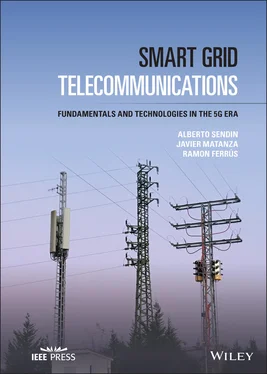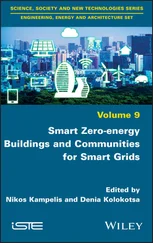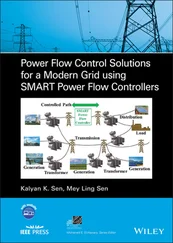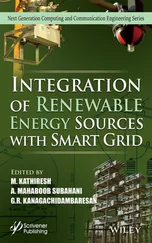Ramon Ferrús - Smart Grid Telecommunications
Здесь есть возможность читать онлайн «Ramon Ferrús - Smart Grid Telecommunications» — ознакомительный отрывок электронной книги совершенно бесплатно, а после прочтения отрывка купить полную версию. В некоторых случаях можно слушать аудио, скачать через торрент в формате fb2 и присутствует краткое содержание. Жанр: unrecognised, на английском языке. Описание произведения, (предисловие) а так же отзывы посетителей доступны на портале библиотеки ЛибКат.
- Название:Smart Grid Telecommunications
- Автор:
- Жанр:
- Год:неизвестен
- ISBN:нет данных
- Рейтинг книги:3 / 5. Голосов: 1
-
Избранное:Добавить в избранное
- Отзывы:
-
Ваша оценка:
- 60
- 1
- 2
- 3
- 4
- 5
Smart Grid Telecommunications: краткое содержание, описание и аннотация
Предлагаем к чтению аннотацию, описание, краткое содержание или предисловие (зависит от того, что написал сам автор книги «Smart Grid Telecommunications»). Если вы не нашли необходимую информацию о книге — напишите в комментариях, мы постараемся отыскать её.
Discover the foundations and main applications of telecommunications to smart grids Smart Grid Telecommunications,
Smart Grid Telecommunications
Smart Grid Telecommunications — читать онлайн ознакомительный отрывок
Ниже представлен текст книги, разбитый по страницам. Система сохранения места последней прочитанной страницы, позволяет с удобством читать онлайн бесплатно книгу «Smart Grid Telecommunications», без необходимости каждый раз заново искать на чём Вы остановились. Поставьте закладку, и сможете в любой момент перейти на страницу, на которой закончили чтение.
Интервал:
Закладка:
Thus, there are some considerations to observe when designing the Smart Grid evolution with Telecommunications:
Smart grids telecommunication solutions must be always understood as a moving target; i.e., any solution, while in the process of being delivered, must be managed observing its next evolutionary step, as due to the longer technology cycles in Smart Grids, telecommunication solutions will change faster that Smart Grid ones.
Telecommunications solutions must come to the Smart Grid infrastructure in the form of technological waves that will be applied to the existing grids, in such a way that along the life cycle of a grid asset, several evolutionary telecommunication solutions will be applied.
Requirements imposed by the Smart Grid must be realistic but challenging, to find a solution within the existing solutions, while simultaneously providing requirements to the next wave of telecommunication solutions for Smart Grids.
Telecommunication solutions must be scalable, meaning that networks and network end‐points will be able to increase in extension and number (respectively) without general network degradation.
No single solution will ever exist for the “smarter grid.” All Smart Grid evolutions will be a consequence of complex decisions, based on regulatory and business aspects, electric and telecommunications technical, and strategy considerations that will configure unique solutions.
1.6.2 Standards for Telecommunications for Smart Grids
The initiatives to standardize ICT‐related Smart Grid solutions started to crystallize in the 2010s. The overarching idea was to define some reference architectures, identify existing standard solutions, identify gaps in them for Smart Grid purposes, and both adopt and adapt existing standards to eventually create new ones where appropriate.
Different efforts have taken place. The reference models and compilations of solutions are useful but lack specific examples on how to use them to provide real solutions. Their value comes from the identification of applicable standards and the process to produce new ones.
Standards ([45]) are instrumental to achieve interoperability, and within their different scopes, they must allow for the interconnection of standard‐compliant equipment from different manufacturers. Standards have many origins; solutions that end‐up being a standard not always start in standardization bodies. The most extreme case is de‐facto standards that, starting purely in industry, may end as a formal standard solution.
IEC, ITU, IEEE, ETSI, CEN, CENELEC and ANSI are probably the main standardization bodies that have engaged with Smart Grids.
IEC's (International Electrotechnical Commission) influence domain is within electrotechnologies (i.e., electrical, electronics, and related technologies) and is probably one of the best options for Smart Grid standards to grow. IEC members are the National Committees (one country, one vote) that appoint delegates and experts to produce consensus‐based standards. The IEC identified hundreds of Smart Grids standards [46].
ITU (International Telecommunication Union) is the United Nations’ agency specializing in ICT and is organized in three sectors, namely, Radiocommunications (ITU‐R), Standardization (ITU‐T), and Development (ITU‐D). A major role of ITU is on radiocommunications (the World Radiocommunication Conference – WRC – being the major reference point), coordinating spectrum allocation at a worldwide level. ITU‐T created a focus group for Smart Grid activities, now within Study Group 15 [47]. Many relevant Smart Grid‐applicable ITU recommendations will be mentioned throughout the different chapters.
IEEE (Institute of Electrical and Electronics Engineers) is a well‐known technical professional organization serving professionals involved in all aspects of the electrical, electronic, and computing fields and related areas of science and technology. IEEE is organized in “societies,” and the ones related to Smart Grid activities are the IEEE Communications Society and the IEEE Power & Energy Society. The IEEE references over 100 standards related to the Smart Grid, and many of them will be mentioned along this book.
ETSI (European Telecommunications Standards Institute) [48] is the European Union (EU) ICT‐related recognized body, that jointly with CEN (Comité Européen de Normalisation, or European Committee for Standardization) [49] and CENELEC (Comité Européen de Normalisation Electrotechnique, or European Committee for Electrotechnical Standardization) [50] are the European Standard Organizations. The ETSI works closely with the National Standards Organizations (NSOs) in the European countries, to an extent that all European Standards (ENs) become national standards of the different European member states. ETSI works very close to the EU institutions, and in the Smart Grid domain, the European Commission issued M/490, M/441 and M/468 mandates to CEN, CENELEC, and ETSI to develop standards for Smart Grids, Smart Metering, and EV charging.
ANSI (American National Standards Institute) [51] works also very closely with USA institutions, to facilitate the standardization and conformity assessment in the United States, for the better performance of the internal market. ANSI develops accreditation services to assess the competence of organizations certifying products and personnel and provides a framework for American National Standards (ANSs) to be developed out of common agreements. The ANSI label may be used when the organization producing the standard meets ANSI requirements; this is the case with the IEEE.
Last but not least, 3GPP (3rd Generation Partnership Project) [52] unites a set of telecommunications standard development organizations (ARIB, ATIS, CCSA, ETSI, TSDSI, TTA, TTC) in a stable environment to produce the so‐called 3GPP technologies' specifications. These specifications cover cellular telecommunications technologies for mobile telecommunications.
1.6.3 Groups of Interest Within Telecommunications for Smart Grids
The impossibility of defining one Smart Grid solution that fits all, draws the attention to interest groups and associations that gather utilities and Smart Grid stakeholders. Some relevant ones are NIST, CIGRE, EPRI, and UTC.
The NIST (National Institute of Standards and Technology) [53] is a nonregulatory federal agency and one of the USA's oldest physical science laboratories now within the U.S. Department of Commerce. In the Smart Grid domain, the NIST specifically established the Smart Grid Interoperability Panel (SGIP) to accelerate standards harmonization and advance into the implementation and interoperability of Smart Grid devices and systems. The SGIP evolved in 2013 as a non‐profit private‐public partnership organization, SGIP 2.0, and in 2017 merged with Smart Electric Power Alliance (SEPA).
The CIGRE (Conseil International des Grands Reseaux Electriques, or International Council on Large Electric Systems) is an international non‐profit association whose objective is to promote collaboration with experts from all around the world by sharing knowledge and joining forces to improve electric power systems today and in the future. CIGRE [54] works with experts in Study Committees (SCs) overseen by the Technical Committee. The SC D2 focuses on ICT applied to “digital networks” 2 from HV to the Distribution grid (smart meters, IoT, big data, EMS, etc.), communication solutions for information exchange in the smart delivery of electric energy [55].
The EPRI (Electric Power Research Institute) [56] is an independent, non‐profit organization, bringing together scientists and engineers and experts from academia and industry. EPRI addresses the challenges in all the aspects of the electricity domain. In the Smart Grid domain, the Intelligrid concept as the architecture for the Smart Grid of the future is one of the best‐known contributions.
Читать дальшеИнтервал:
Закладка:
Похожие книги на «Smart Grid Telecommunications»
Представляем Вашему вниманию похожие книги на «Smart Grid Telecommunications» списком для выбора. Мы отобрали схожую по названию и смыслу литературу в надежде предоставить читателям больше вариантов отыскать новые, интересные, ещё непрочитанные произведения.
Обсуждение, отзывы о книге «Smart Grid Telecommunications» и просто собственные мнения читателей. Оставьте ваши комментарии, напишите, что Вы думаете о произведении, его смысле или главных героях. Укажите что конкретно понравилось, а что нет, и почему Вы так считаете.












